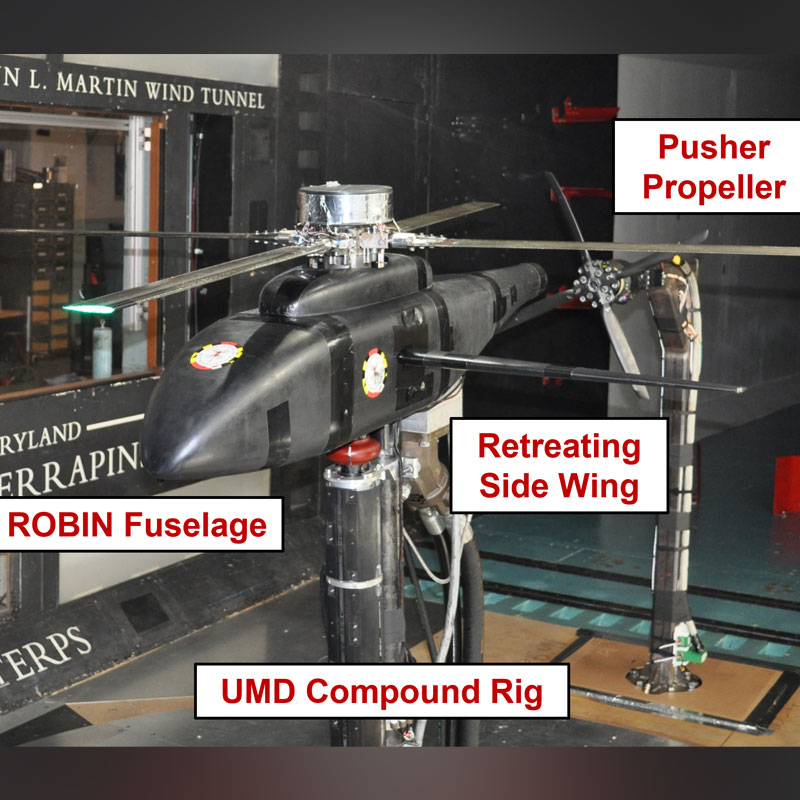
|
 |
UMD’s compound helicopter rig in the Glenn L. Martin Wind Tunnel, the first university-led wind tunnel test of a lift and thrust compounded Mach-scaled rotor with a single wing. |
|
University of Maryland (UMD) Department of Aerospace Engineering Ph.D. student Vivek Uppoor was recognized with the best paper award from the Dynamics Committee technical session at the Vertical Flight Society’s (VFS) 80th Annual Forum & Technology Display.
His paper, “Aeromechanics Investigation of a Dual-Wing Lift Compounded Slowed Mach Scale Rotor,”  investigated the effect of lift compounding on the aeromechanics of a rotorcraft, and more specifically, the Mach-scaled UMD compound rotor rig which was tested in the Glenn L. Martin Wind Tunnel in 2023. investigated the effect of lift compounding on the aeromechanics of a rotorcraft, and more specifically, the Mach-scaled UMD compound rotor rig which was tested in the Glenn L. Martin Wind Tunnel in 2023.
That test was the first university-led wind tunnel test of a lift and thrust compounded Mach-scaled rotor with a single wing. The UMD rig, shown at right, is uniquely capable of measuring loads at three distinct locations: rotor, wing, and propeller.
“We used the data from this test to validate the comprehensive analysis models used in the paper,” explained Uppoor. “And, we compared the asymmetric single wing (wing only on the left, retreating, side of the helicopter) and dual wing (wings on both sides of the helicopter) configurations at various wing incidence angles and rotor shaft tilt angles to identify the configurations that yield the best performance and minimize blade and hub structural loads.”
According to Uppoor, his research identified several key conclusions: single wing configuration maximizes lift to drag ratio (best performance); high wing incidence angle minimized blade and hub vibratory loads; rearward tilted rotor minimizes required rotor torque, and wings negatively interfere with the rotor aerodynamically.
“Lift compounding with wings allows a helicopter to achieve higher speeds than conventional helicopters with greater efficiency,” explained Uppoor. “This results in decreased travel time and better fuel economy.”
Uppoor is a second-year Ph.D. student, and graduated with his B.S. in aerospace engineering from UMD in 2022. Working under Distinguished University Professor Inderjit Chopra in the Alfred Gessow Rotorcraft Center, he researches lift and thrust compounded rotor systems at high advance ratios using wind tunnel testing and comprehensive aeromechanics modeling. Beyond his current research, Uppoor is passionate about aircraft design and intends to enter the VTOL industry to work on initial-stage vehicle development after completing his Ph.D.
Related Articles:
UMD Students Sweep 2025 VFS Student Design Competition
Seven UMD Students Receive 2025 Vertical Flight Foundation Scholarships
Seven Maryland Students Receive Vertical Flight Foundation Scholarships
Five UMD Alumni Receive Vertical Flight Society Honors
Strengthening Support Networks for Engineering Students
Logan Selph Awarded NSF Graduate Research Fellowship
Akin Receives 2025 ICES Award for Technical Excellence
Gebhardt Named 2025-26 MWC ARCS Scholar
Rudolph Awarded Women in Defense Scholarship
Joseph Mockler Awarded DoD SMART Scholarship
June 18, 2024
|

